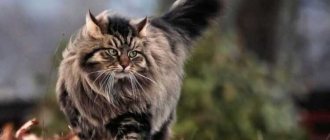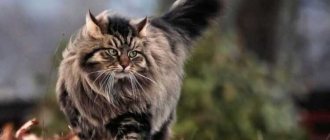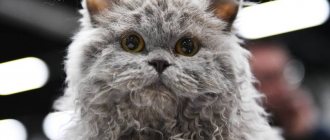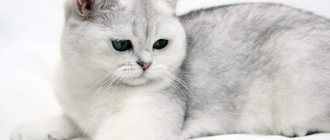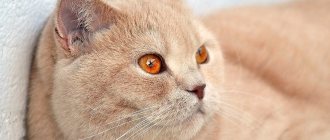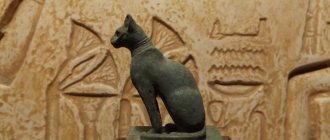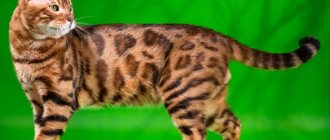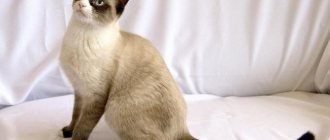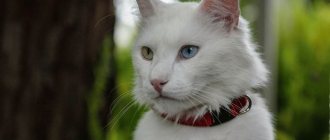Origin of the Turkish Angora breed
The description of the Turkish Angora breed begins with wild African cats tamed by humans. After a gene mutation, the appearance of cats underwent changes: the coat became long and white.
- Angoras trace their pedigree back to the 15th century. According to ancient legend, the Prophet Muhammad had a white cat with different eyes named Mueza.
- Angoras owe their name to the capital of Turkey - Ankara, which was formerly called Angora.
- In the Ottoman Empire, Angora cats were very popular, but only rich people could keep them.
- In the 17th century, majestic purrs began to appear in England and France. They were given to ambassadors and European monks.
- The snow-white handsome man was presented to Empress Catherine by Count Potemkin.
Wanting to make the Persians' fur longer, the British began crossing them with Angoras. This resulted in a decrease in the number of purebred Turkish women. At the beginning of the 19th century, the Turkish authorities recognized them as the property of the nation and prohibited their export outside the country.
The Ankara Zoo has created a center for breeding the white Angora breed. Felinologists from Europe and America acquired several individuals of the breed from the Turkish zoo. In 1973, a standard for the White Angora breed was registered. Later, breeders began to breed Turkish kittens of different colors. In 1987, the world felinological association recognized the Turkish Angora breed as white and all shades.
Currently, getting an Angora is not a problem for Russian cat owners. In order for the Angora beauty to live in a family for a long time and please her owners, you need to learn as much as possible about the characteristics of the breed and the rules of education.
Diseases of the Angora cat breed
The cat is included in the list of long-lived breeds, and, nevertheless, some Turkish Angora cats are sometimes diagnosed with a cardiovascular disease called hypertrophic cardiomyopathy.
There is also a unique disease of Turkish Angoras: ataxia. When the disease occurs, the coordination of movements in a kitten several weeks old is impaired. Breeders remove such sick pets from breeding and test the animals for the presence of unwanted genes.
The third deviation of Turkish Angoras is possible congenital deafness in blue-eyed offspring from two white animals.
Appearance of the breed
Angora is a breed of semi-longhaired cat without undercoat. The graceful and flexible Turkish female is small, 30 cm in height, weighing about 4 kg (males reach 6 kg).
According to accepted standards, Angora has the following characteristics:
- The body is toned, with dry and developed muscles;
- The coat is thin, thick, and has a collar on the neck. It is thicker on the belly and hind legs;
- The tail is fluffy and long, slightly tapering towards the tip;
- The ears are large and erect. Inside with wool, there are tassels at the ends;
- The eyes are a little slanted. Large, almond-shaped. The Russian Angora has green eyes. Kittens with different eye colors are more valuable;
- Limbs - long and slender, elastic muscles. The photo of the Turkish Angora shows how elegant its fluffy “pants” look. The front legs are slightly shorter than the hind legs;
- The head is wide, pointed towards the bottom.
Conclusions about the breed
Known beyond its hometown of Ankara Zoo, the Turkish Angora is renowned throughout the world for its virtues:
calm and affectionate character, ability to get along with small households and lack of desire to spoil interior items;
cats have good health and a high level of immunity;
The amazing grace, elegance and beauty of the fur do not require much care and heavy maintenance.
On the Internet, lovers share various videos about the antics of their Angoras, and it becomes clear what causes such love on the part of people.
Description and colors
Purebred Angora cats come in not only white, but also in a variety of colors.
- White is the most popular color with a pink nose and pink paw pads.
- Black color. The paw pads and nose are brown or black.
- Cream shade combined with white stripes.
- Blue is a delicate silvery coat color. The nose and paws are the same color.
- Two-color angoras are one third white, and the rest of the wool is a different color.
- Red cats - without adding another shade. Dense, rich color, red nose and paws.
- Tortoiseshell is the original color of the Angora - a mixture of black, red and cream shades.
- Calico is a spotted Turkish Angora, red and black. Most of the fur is white.
According to breed standards, cats cannot be chocolate, lilac or Himalayan in color. This is considered a cull.
Needs
Turkish Angoras get along well with children if they have time to get used to them. However, it is important to ensure that a very young child does not painfully grab the cat’s fur or pull its tail. They will not tolerate such treatment, unlike, for example, Himalayan cats.
Angoras can be friendly towards other cats or dogs if introduced correctly. However, these cats do well without companions and usually do not experience stress if left alone.
Like all cats, Turkish Angoras need a variety of toys and several scratching posts for a happy, active life (and to keep your furniture snag-free). They also like to climb higher, and it’s good if you have points in the house from which they can observe their possessions.
A tall cat tree, hanging shelves or a hammock can become your pet's favorite place. If there is nothing like that, most likely the cat will climb onto the cabinet or door.
Character
Daniel Defoe wrote correctly about furry friends: “He who has a cat need not be afraid of loneliness.” As well as possible, this statement accurately describes the character of the Turkish Angora.
If the family is large, then the fluffy will choose only one owner and will serve him faithfully. Lonely people enjoy spending the evenings with a furry friend.
- The active Turkish handsome man loves to play with a ball or his toy from birth. Gets everyone involved in the game and jumps high. With age, he becomes a sedate, even phlegmatic cat.
- Curiosity is the angora's favorite pastime. She must be aware of everything that happens in the house. He climbs high and observes the life of his household. He is friends with children, but if someone pulls his tail, he will fight back.
- In nature, he can hunt small animals - the habits of his ancient ancestors affect him. Sometimes the Angora breed is compared to dogs. Attached to the owner, loyal, amenable to training.
- If you teach a kitten from a young age to fetch objects, open doors or turn on lights, then as the cat grows up it will do this with pleasure. She can do this for hours. In addition, the Angora loves to be the center of attention and will distract the owner from any task.
Fluffy Turkish women have quick wits and high intelligence. They are called the loudest purring and talkative of all cat breeds. They love water very much and ask for water treatments more often than usual.
Buy a Turkish Angora kitten
Since the Turkish Angora is quite common in Russia, there are usually no difficulties in purchasing it: there are many nurseries in different countries and buying a kitten is not a problem.
A person who cannot distinguish a pedigree cat from a mestizo should ideally seek help from a specialist breeder, and not on sites like Avito or Yula: it is doubtful that an official cattery will offer its services there.
If a cat is white, this is not proof that it is a true Angora; it is not always white: it may be an Angora chinchilla, a Turkish shorthair, or even a Van cat.
Cats are not rare, so the cost of an Angora cat kitten with a pedigree and a pure genetic line is about 25,000 rubles
.
Pet and breed class kittens are cheaper, their price ranges from 5,000 to 20,000
rubles.
What to call a Turkish Angora
Naming a furry fairy boy or girl Angora is not so easy. This is because the kisul is so pretty - giving any nickname to such an animal is simply out of hand.
Turkish Angora kittens are distinguished by their beauty in any photo, and in real life these bundles of happiness even more so deserve special names. You can ask the breeder for advice, contact other owners, or choose a beautiful nickname from a ready-made list. But it’s better to name the cat so that it reacts sensitively to the nickname and it suits it perfectly.
| Girl | Boy | ||
| Taiga Palma Java Ruby Snezha Tesla Bentley Gris Frida Fiesta Whitey Iva Tella Utah Besta | Kuzya Yamka Fronda Caramel Bella Syusya Dzhulya Gerta Maruska Gucci Yara Aina Snezhinka Lota Chucha | Foxy Cornet Prime Filya Aramis Chips Carat Saffron Luxie Leo Donut Zhorzhik Eunice Zieger Duchess | Syava Behemoth Mozambique Assar Obormot Fonya Mirlan Evrik Elbar Makhno Oboe Whitefish Darley Nicolas Dyma |
Maintenance and care
Angoras are easy to care for. Although their fur does not mat and does not need to be brushed every day, it is still necessary to know all the intricacies of keeping an animal.
- The coat is smooth, even, without matting. It is enough to brush 2 times a week with a rubber brush. You can bathe once every 3 months, more often only for white cats. Although angoras take excellent care of their skin on their own.
- Teeth should be brushed at least once a week with a soft brush. They buy a special paste for cats.
- Claws are trimmed regularly. The cat likes scratching posts - she needs it for training “combat weapons”. If you do not trim, you can wear anti-scratch caps.
- Ears and eyes are wiped with damp swabs and sticks at least twice a month.
- To maintain whiteness, oil-based products are used to prevent the wool from turning yellow.
By nature, Angoras are very clean. When bathing, be sure to cover your ears with cotton swabs. The pet should dry in a warm place, without drafts.
Cat food
Proper nutrition plays an important role in raising a Turkish Angora. You can feed the fluffy beauty with ready-made food or natural products. If you consider how much a Turkish Angora costs (not a little), then the food should be balanced and of good quality. You cannot feed a purebred cat food from the table. The gloss and silkiness of the coat depends on the composition of the food.
What can you give your cat:
- Meat – lean, cut into small pieces. You can cook it, and if raw, scald it with boiling water;
- Chicken and quail eggs are given no more than twice a week;
- Cottage cheese, yogurt;
- Boiled vegetables are beneficial for Angoras;
- Fish - very rarely, as there is a danger of urolithiasis;
- Vitamins in tablets are added to food, fish oil.
What not to feed:
- The cat's stomach will not accept whole milk;
- Sweets;
- Flour and baked goods;
- Fatty food;
- Liver should not be given to white pussies - the color of the coat will deteriorate;
- Salty and peppered foods.
Small kittens need to be fed frequently - 4 times a day. Older cats are fed 2 times a day. Food should be rich in calcium and proteins - do not forget that this is a breed of predators. Among the Angoras there are vegetarians - they love fresh cucumbers and even raw potatoes.
Dry and wet food contains the necessary vitamins and minerals for the Turkish breed. You should buy only expensive varieties, premium or super premium classes.
You can feed dry ready-made food for long-haired breeds. They contain additives to remove licked hair from the cat’s stomach. Be sure to place a bowl of water next to your food.
Other meanings of this word:
Random riddle:
Two slender columns Hold a huge castle: With two windows, Ledges, steps. The columns do not stand still - They walk with the castle together.
Random joke:
Eyes: We see the beer dot. Brain: Legs, turn. Legs: And our lace came undone. Mouth: I'd like a couple, please. Eyes: The beer is cloudy, disgusting. Brain: Never mind, the stomach will sort it out. Rectum: Yeah, you'll have to figure it out through me again. Brain: You can't get used to it. Stomach: Oh, that’s good. Mouth: A couple more. Hands: Shut up, there’s no money Brain: I’m having a blast. Bladder: It’s always like this, the tops get high, and the bottoms work hard. Stomach: I want to sing. Mouth: I’ll sing for you. Kidneys: (breathe deeply) Bladder: Oh, I can’t Brain: Hey, legs, help the bladder. The right one rose and fell. The left one rose and fell. One, two, one, two. Legs: Damn, the lace came undone. Brain: They convinced me. Body, bend over. Vestibular apparatus: I'm switching off. Stomach: Right now, I’ll sing. Brain: Body, put it aside! Vestibular apparatus: Turning on. Stomach: I’ll sing anyway. Bladder: It's now or never. Brain: Got you. Feet, forward around the corner. Legs: And our lace came undone. Brain: I told you, around the corner! Vestibular apparatus: There were happy days. Eyes: To what angle? Brain: To the nearest one. Right eye: Towards the right. Left eye: Towards the left. Legs: And we stepped on a shoelace. Lump on forehead: Hello guys. Bladder: Faster, faster! Legs: One, two, one, two. Bladder: Ufff! Mouth: A couple more. Bump on the forehead: That's right, I want a brother. Brain: Go deaf, you brainless bruise. Shishka: I am a hematoma, you are the bruise. Kidneys: We're fed up, we're switching off. Right eye: Oh, what a girl is coming. Left: Where? Spine: I can smell blonde in my spinal cord! Eyes: There is a pillar ahead. Head Boom! Eyes: Oh, what stars. Brain: I see it myself, take control. Spine: 5. 4. 3. 2. 1. Let's go! Mouth: Earth in the porthole.
Did you know?
Many people, hearing their voice recorded on tape, are disappointed. In order for the voice not to sound monotonous, it must cover at least an octave. Almost every voice can be corrected and remade before the age of twenty-one; in adulthood it is much more difficult to change.
Scanwords, crosswords, sudoku, keywords online
A beauty with a regal appearance and the most delicate fur deserves interest in her person - the Turkish Angora cat enjoys respect and love. Such an animal is revered not only in its homeland, but also in different parts of the world. There is no debate about whether such external beauty is combined with a cat’s nature and character - definitely, this queen of human souls is smart, affectionate and peaceful. Is it worth having such a luxurious charmer in your home? It’s a simple question.
Diseases and treatment
High-quality nutrition and comfortable conditions help the pussy maintain excellent health. An annual visit to the veterinarian, starting from 2 months, regular vaccinations are necessary conditions for angora.
However, there are ailments that need to be taken into account when raising.
- Cardiac activity. A sedentary lifestyle and obesity lead to this disease. To avoid this, you need to walk your pet more often, run and play. This is especially true for adult cats. Give them toy mice and balls. You can hang toys to develop the muscular system.
- Deafness occurs in a white cat if it is mated with a white cat. Other colors do not have this disease.
- Kidney problems occur with frequent feeding of fish and seafood. You need to remove these foods from your cat's diet and contact your veterinarian.
- Ataxia is a motor disorder, a neuromuscular disease. Occurs more often in kittens. A shaky gait from side to side, trembling in the body are signs of illness, in which case it is necessary to consult a specialist. Drug treatment is prescribed or surgery is performed. The disease is curable.
If you take care of the health of your furry beauties, they will live a long time, up to 18 years, as strong and playful friends.
Choosing a kitten
The best way to get a fluffy ball of Angora breed is to contact a nursery. The price of a Turkish Angora ranges from 5,000 to 15,000 rubles. It all depends on the color of the kitten. Elite kittens cost up to 25 thousand rubles.
When choosing a furry pet, pay attention to such qualities as:
- Age – at least 3 months. Feeds independently, is litter box trained;
- Playfulness - the kitten should be cheerful and active;
- Hearing - check the reaction with a clap near each ear;
- Clean eyes and ears;
- The stomach should be soft; if it is elastic, there may be worms.
We should not forget about all the necessary documents confirming vaccinations, status and pedigree. If you buy an Angora kitten from private breeders, all certificates are checked more carefully - you can be deceived.
Having brought home a new tenant, you need to introduce him to the territory of his residence. Show tray, food bowls. The Turkish Angora is a kind and faithful friend for many years.
How to choose a kitten
If you want to buy a healthy kitten that truly belongs to the Angora breed, contact only specialized nurseries. Be sure to look at the parents' pedigree. Buyers line up for snow-white kittens several months before the birth of the next litter. If you want to get a furry friend sooner, pay attention to Turkish Angoras of other colors. The kitten must stand confidently on its feet and be accustomed to food. Healthy animals are playful, although cautious, and do not have kinks on the tail or areas of matted fur.

